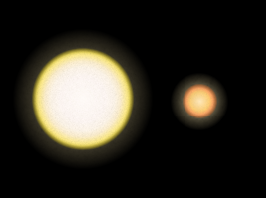Gliese 581
 Size of the Sun (left) and Gliese 581 (right). | |
| Observation data Epoch J2000.0 Equinox J2000.0 | |
|---|---|
| Constellation | Libra[1] |
| Right ascension | 15h 19m 26.8269s[2] |
| Declination | −07° 43′ 20.189″[2] |
| Apparent magnitude (V) | 10.56 to 10.58[note 1] |
| Characteristics | |
| Evolutionary stage | Main sequence |
| Spectral type | M3V[5] |
| B−V color index | 1.61[6] |
| Variable type | BY Dra[7][note 2] |
| Astrometry | |
| Radial velocity (Rv) | −9.5 ± 0.5[6] km/s |
| Proper motion (μ) | RA: −1221.289±0.160[2] mas/yr Dec.: −97.237±0.105[2] mas/yr |
| Parallax (π) | 158.64 ± 0.35[2] mas |
| Distance | 20.56 ± 0.05 ly (6.30 ± 0.01 pc) |
| Absolute magnitude (MV) | 11.6[11] |
| Details | |
| Mass | 0.31 ± 0.02[12] M☉ |
| Radius | 0.299±0.010[13] R☉ |
| Luminosity (bolometric) | 0.013[5] L☉ |
| Luminosity (visual, LV) | 0.002[note 3] L☉ |
| Surface gravity (log g) | 4.92±0.10[14] cgs |
| Temperature | 3,480 ± 48[14] K |
| Metallicity [Fe/H] | −0.33 ± 0.12[14] dex |
| Rotation | 132.5±6.3 d[15] |
| Age | 8+3 −1[12][16] Gyr |
| Other designations | |
| Database references | |
| SIMBAD | The star |
| e | |
| b | |
| c | |
| d | |
| f (artifact) | |
| g | |
Gliese 581 (/ˈɡliːzə/) is a star of spectral type M3V (a red dwarf) at the center of the Gliese 581 planetary system, about 20 light years away from Earth in the Libra constellation. Its estimated mass is about a third of that of the Sun, and it is the 89th closest known star to the Sun. Gliese 581 is one of the oldest, least active M dwarfs, its low stellar activity bodes better than most for its planets retaining significant atmospheres and from the sterilising impact of stellar flares.[18]
History of observations[]
Gliese 581 is known at least from 1886, when it was included in Eduard Schönfeld's Southern Durchmusterung (SD)—the fourth part of the Bonner Durchmusterung. The corresponding designation is BD -7 4003.[19]
Characteristics[]
The name Gliese 581 refers to the catalog number from the 1957 survey Gliese Catalogue of Nearby Stars of 965 stars located within 20 parsecs of the Earth. Other names of this star include BD-07° 4003 (BD catalogue, first known publication) and HO Librae (variable star designation). It does not have an individual name such as Sirius or Procyon.[6][17] The star is a red dwarf with spectral type M3V, located 20.4 light-years away from Earth. It is located about two degrees north of Beta Librae, the brightest star in the Libra constellation. Its mass is estimated to be approximately a third that of the Sun, and it is the 89th closest known star system to the Sun.[20]
An M-class dwarf star such as Gliese 581 has a much lower mass than the Sun, causing the core region of the star to fuse hydrogen at a significantly lower rate. From the apparent magnitude and distance, astronomers have estimated an effective temperature of 3200 K and a visual luminosity of 0.2% of that of the Sun.[21] However, a red dwarf such as Gliese 581 radiates primarily in the near infrared, with peak emission at a wavelength of roughly 830 nm (estimated using Wien's displacement law, which assumes the star radiates as a black body), so such an estimate will underestimate the star's total luminosity.[5] (For comparison, the peak emission of the Sun is roughly 530 nm, in the middle of the visible part of the spectrum.) When radiation over the entire spectrum is taken into account (not just the part that humans are able to see), something known as the bolometric correction, this star has a bolometric luminosity 1.3% of the Sun's total luminosity.[5][21] A planet would need to be situated much closer to this star in order to receive a comparable amount of energy as the Earth. The region of space around a star where a planet would receive roughly the same energy as the Earth is sometimes termed the "Goldilocks Zone", or, more prosaically, the habitable zone. The extent of such a zone is not fixed and is highly specific for each planetary system.[22] Gliese 581 is a very old star. Its slow rotation makes it very inactive, making it better suited than most red dwarfs for having habitable planets.[18]
Gliese 581 is classified as a variable star of the BY Draconis type, and has been given the variable star designation HO Librae. This is a star that exhibits variability because of the presence of star spots combined with the rotation of the star. However, the measured variability is close to the margin of error, and, if real, is most likely a long term variability.[5] Its brightness is stable to 1%.[23] Gliese 581 emits X-rays.[24]
Planetary system[]
| Companion (in order from star) |
Mass | Semimajor axis (AU) |
Orbital period (days) |
Eccentricity | Inclination | Radius |
|---|---|---|---|---|---|---|
| e | ≥1.7 ± 0.2 M |